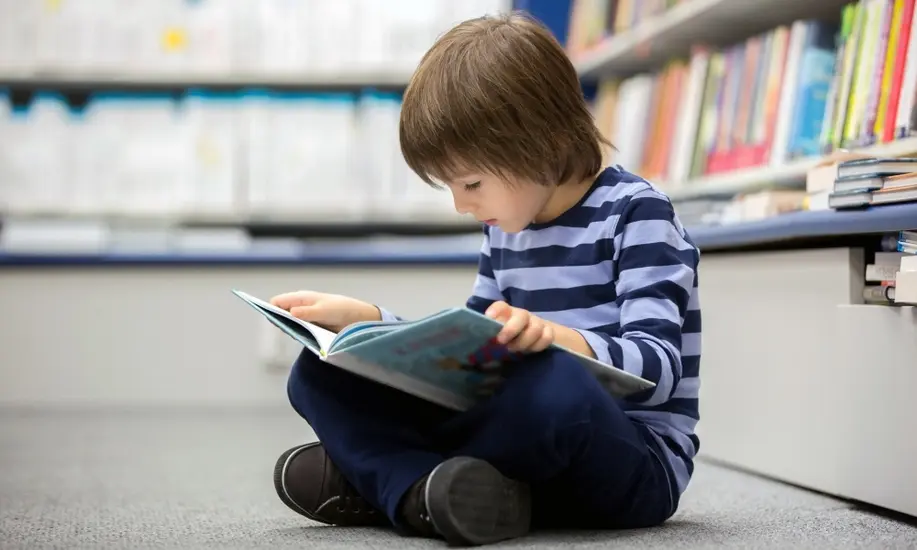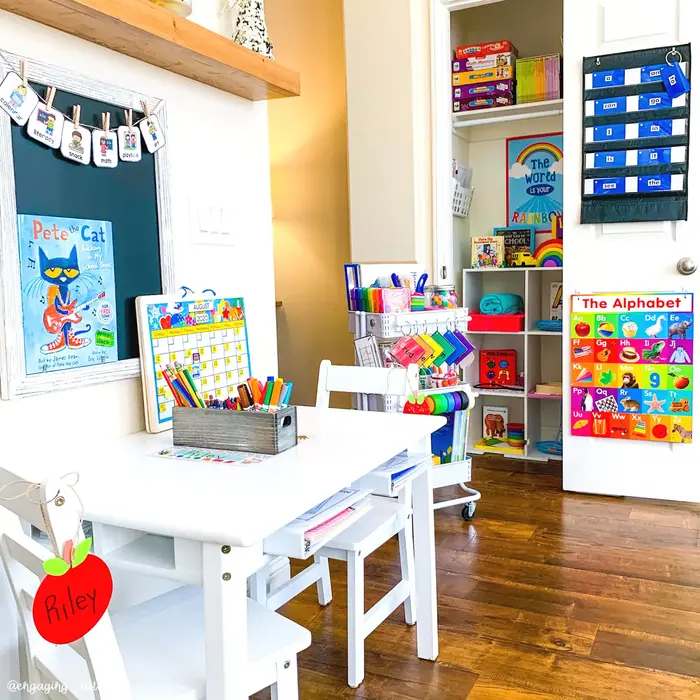For younger kids, learning at home rather than in a regular classroom may be confusing. Our bodies and brains prepare when we go into different environments. “When we enter a learning space, our brain says, ‘OK, it’s time to focus.’ So, if we do so many activities in one same space at home, it literally will lead to some sort of confusion.”
Without a home environment set up suitably for learning, the dangers of distraction appear out of all sorts of corners. In a virtual classroom, creating a productive, motivated learning environment can go a long way in lowering the risk of interruptions.
Not sure how to create a learning space for your child, check out our list of ways to create a successful at-home learning environment!
8 Steps to create a productive home learning environment

Step 1: Make a Special School Space
You should set up a makeshift classroom in a “little corner” in your home where the child will not be distracted or interrupted. It does not need to be a large area. All they need is enough space for their laptop or tablet, as well as some school supplies.
Consider how much light is available in your home. Natural light is fantastic via windows, but it isn’t constantly bright and sunny outside. Make sure you have enough light sources to keep the room bright even on dark, gloomy days.
This area should only be used for homework and not for extracurricular activities. You don’t want the area to act as a playroom because it can cause the kids to lose attention.
If you don’t have place for a desk elsewhere, please set aside at least a corner of your dining table. It’s critical for children to feel like they have a consistent place to report to – something they are familiar and associate with learning.

Step 2: Make Your Space Comfortable
Is the room you’re considering using for your homeschooling courses well-ventilated? Is the room properly insulated? You don’t want to pick a space that is hot in the summer but cold in the winter. If you choose a location such as a converted garage or basement, make sure you can manage the temperature so that everyone can concentrate on their homework rather than their discomfort.
Consider investing in a decent space heater if you know your homeschooling environment gets cold in the winter. In the summer, you may require additional air conditioning power or a strong fan to move air around the space.
Not every child enjoys sitting on a chair all day. Provide a variety of seating options in the area to accommodate individuals who choose to sit on the floor or on a beanbag chair. For deskwork, you may also include yoga balls.
For children, noise can be a major source of distraction. Make an effort to keep your classroom quiet. If your children like soothing music, it can be a simple method to block out some of the noise that you might otherwise find annoying.
Using the power of aroma is another skill of the trade. Essential oils can be used to not only change the vibe of a room, but also to build a link between aroma and learning. Rosemary, which increases thinking and memory, while peppermint, which improves focus and attention, are two fantastic fragrances to utilise. “Using a diffuser with essential oils begins to prepare your brain to learn.When you smell the rosemary and peppermint, you might think to yourself, “Oh, I need to get ready to learn.”
A similar effect can be achieved by listening to music. Studies have proven that classical and smooth jazz can aid memory.

Step 3: Organize a Well-Lit Area
Believe it or not, lighting is a crucial aspect in creating effective learning environments. According to Christopher Alexander, Emeritus Professor of Architecture at UC Berkeley, low levels of light in classrooms affect students’ ability to regulate their normal sleep and concentration cycles. Another study found out that the more natural light (or lighting that mimicked natural sunlight), the better the students’ attendance, achievement, and overall health.
These studies show that lighting has an impact on a child’s energy, attention, and achievement.
Light yellow is the ideal colour for studying since it makes individuals feel calm and concentrated. Dark blues, which cause tiredness, should be avoided, according to the therapist.
Windows that allow natural light into the area can be useful, but if the room is in direct sunlight, you may want to put blinds or curtains to keep the room cool.
If you do not have windows or good lighting in the space where your child learns, you can also use mirrors! Place a mirror across from a window to reflect more of the natural light into the room.

Step 4: Make Your Space Fun
Traditional classrooms often have posters and other fun things on the walls to create a more inviting space for students past the tile floors and beige walls. You can make your schooling environment as bright and entertaining as you want at home. You can also involve your children in the decorating process. Use a lot of colors to make the space unique and fun.
A few ideas for making your classroom a fun place for the kids includes painting the room a soothing color or add an accent wall. You can also incorporate color with furniture, a rug, and throw pillows. Hang student artwork on the walls and put up fun, educational posters.
You may place chalkboards and markerboards in classrooms. They make life a lot easier for teachers and students alike. Consider getting one or the other to use in your schoolroom. If you really want to get creative, you could use chalkboard paint to make a wall your chalkboard.
Don’t forget that learning should be fun. When possible, use toys as teaching tools. Not only will this make learning more enjoyable, but it will add a bit of whimsey to the room as well.

Step 5: Collect Books and Leave Room for Growth
Make sure you have enough of books ready and leave room for growth! Research shows that children in homes where books are readily available benefit—in terms of improved test scores—from their mere presence. This is especially true in low-income and low-education households. The research even shows that no matter how many books you already have in your home, adding more will benefit your children even more.
So, whether you purchase them from secondhand stores, the library, or bookstores, the more books you have in your house, the better! Stocking your shelves with a lot of books encourages kids to explore new interests and choose reading as a pastime.
Don’t be afraid to leave certain areas blank. You don’t have to stuff every nook and cranny of your study space with books and educational materials. The learning space should have room to change as your child’s interests, educational abilities, and passions evolve. Allow them to switch things up by adding fresh books or educational items to the mix!

Step 6: Create a Place for Supplies
Have that cart or basket close with their school supplies, reading books, and laptop, so it feels like a devoted learning environment and you don’t have to look for your materials from far.
The worst mistake you might make is to forget to set aside a space for basic school supplies. If your kids have to go on a five-minute hunt for a pencil every day, it will eat up valuable time and be a major distraction. To prevent continuously searching for simple things throughout the day, make sure your classroom has a well-stocked supply station.
Rulers, staplers, markers, and other goods that aren’t needed as frequently can be kept in a supply cabinet or station. Use labels to be creative and keep the place orderly.

Step 7: Plan a Schedule Corner
Every day, begin with a consistent routine that signifies the start of learning time. Use post-its or taped pieces of paper to recap the day of the week, the date, and let your children check in on how they’re feeling on a simple piece of poster board. Then, using visual schedules to go over the day’s plan. See how to plan your kid schedule effectively.
For young learners, predictability is essential. For example, try to keep reading time in the morning and math time after lunch. However, you could let the kids have some ownership over when to do other activities like outside time, music breaks, and more.
Create a location to keep all of your schedules and consider colour coding to help you and your learners understand how the components will function together if you have numerous children at home with varied learning schedules and online/remote learning requirements.

Step 8: Keep the Room Clean
For young learners, clutter and loose items might be distracting. Only bring out what you need for the day; anything else may be put away until you need it again.
As a homeschooling parents, organisation will be your best friend. Sort your classes and activities by topic and age. This will allow you to only take out what you need for each lesson.
Get everything tidied up and put away at the end of the day. You can enlist the assistance of your children, regardless of their age, to do this chore. Teaching your children to put stuff away when they are finished with them is an excellent approach to keep your classroom from becoming too cluttered.
This was a delight to read. You show an impressive grasp on this subject!
I am really inspired together with your writing skills and also with the structure on your weblog. Is this a paid theme or did you modify it yourself? Anyway keep up the nice quality writing, it’s uncommon to peer a great blog like this one nowadays!
Say thank you you an eye to sharing this!
It’s ever interesting to see unalike perspectives on this topic.
I increase the stab and charge stake into this post – it provides valuable insights and definitely gives me something to dream about.
Looking forth to more felicity like this!